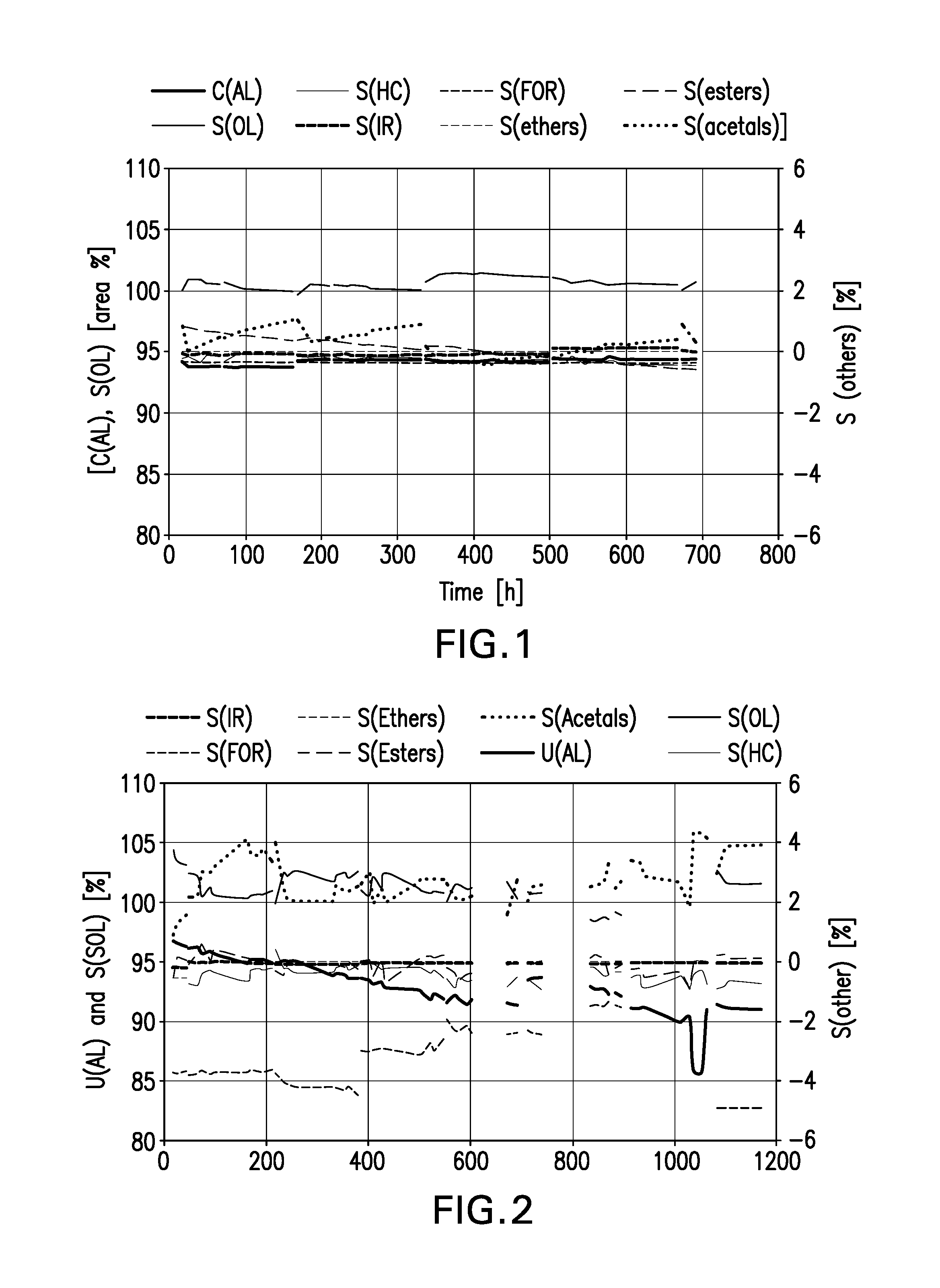Chromium-free hydrogenation of hydroformylation mixtures
a technology of hydroformylation mixture and hydrogenation mixture, which is applied in the direction of catalyst activation/preparation, metal/metal-oxide/metal-hydroxide catalyst, physical/chemical process catalyst, etc., can solve the problems of high cost, large complexity, and unfavorable second reaction, so as to save capital costs
- Summary
- Abstract
- Description
- Claims
- Application Information
AI Technical Summary
Benefits of technology
Problems solved by technology
Method used
Image
Examples
example 0
[0074]A moulded porous aluminium oxide support (extrudates with a diameter of about 1.2 mm, a BET surface area of about 260 m2 / g and a pore volume of about 0.7 ml / g) is impregnated with an ammoniacal aqueous solution containing nickel and copper compounds. The aqueous impregnation solution is obtained from copper(II) hydroxide carbonate, nickel hydroxycarbonate paste, ammonium carbonate, aqueous ammonia solution and water. The impregnation can take place by various customary methods, e.g. spray impregnation, vacuum impregnation or steeping at atmospheric pressure. The impregnation can take place such that the amount of solution is chosen such that the pores are filled partly or completely with impregnation solution or the support is impregnated in an excess of solution. After the impregnation, the material is dried in the stream of air (at temperatures below 100° C.). The dried precursor is then calcined in the stream of air (at temperatures of 450° C.). Afterwards, nickel and coppe...
example 1
[0075]A reaction discharge from the cobalt-catalysed hydroformylation of dibutene was hydrogenated continuously in a circulation apparatus at 180° C. and 25 bar absolute over 150 g of catalyst in the liquid phase. 0.90 l of starting material were pushed through per hour for a circulation of 24 l / h. The amount of off-gas was 5 l / h (STP). A chromium-free Ni / Cu catalyst on Al2O3 support material prepared according to Example 0 was used. The composition of the use material used is shown in Table 1.
[0076]
TABLE 1Composition of the use mixture comprising C9 aldehydesComponentHC[a]IR[b]AL[c]FOR[d]OL[e]Ethers[f]Esters[g]Acetals[h]WaterRemainderContent [%5.50.169.20.321.70.00.81.60.70.0by mass][a]HC: Hydrocarbon;[b]Interim run;[c]C9-aldehydes;[d]C9-formates;[e]C9-alcohols;[f]C9 / C9-ethers;[g]C9 / C9-esters;[h]C9-C9-acetals
[0077]The composition of the product mixture is shown in Table 2.
[0078]
TABLE 2Composition of the product mixture according to Example 1 (data in % by mass)t [h]HC[a]IR[b]AL[c]F...
example 2
[0080]The same use mixture and the same apparatus as in Example 1 were used. A chromium-free catalyst according to the invention was used. The composition of the resulting product mixture is shown in Table 3.
[0081]
TABLE 3Composition of the production mixture according to Example 2t [h]HC[a]IR[b]AL[c]FOR[d]OL[e]Ethers[f]Esters[g]Acetals[h]remainder185.80.02.20.589.10.00.21.80.3255.80.02.40.488.40.00.72.00.2415.80.02.50.588.10.00.62.20.3496.20.02.60.687.50.00.52.30.3666.20.02.60.687.30.00.72.30.3736.50.02.90.785.90.00.92.80.2906.50.02.80.686.60.00.52.80.1976.50.03.00.786.00.00.82.90.21626.30.03.50.785.30.00.63.50.11696.50.03.30.785.60.00.63.20.11866.60.03.30.785.70.00.53.20.11936.50.03.30.785.70.00.53.30.02106.60.03.40.785.70.00.53.00.02176.30.03.50.785.40.00.53.60.02345.80.03.40.587.30.00.42.60.02415.80.03.40.587.10.00.62.30.22605.70.03.40.487.30.00.62.30.23305.80.04.20.585.90.00.62.30.73375.80.04.10.486.40.00.62.60.03545.90.04.20.486.40.00.52.50.03615.80.04.40.586.00.00.72.50.23785....
PUM
| Property | Measurement | Unit |
|---|---|---|
| specific surface area | aaaaa | aaaaa |
| temperature | aaaaa | aaaaa |
| temperature | aaaaa | aaaaa |
Abstract
Description
Claims
Application Information
 Login to View More
Login to View More - R&D
- Intellectual Property
- Life Sciences
- Materials
- Tech Scout
- Unparalleled Data Quality
- Higher Quality Content
- 60% Fewer Hallucinations
Browse by: Latest US Patents, China's latest patents, Technical Efficacy Thesaurus, Application Domain, Technology Topic, Popular Technical Reports.
© 2025 PatSnap. All rights reserved.Legal|Privacy policy|Modern Slavery Act Transparency Statement|Sitemap|About US| Contact US: help@patsnap.com

